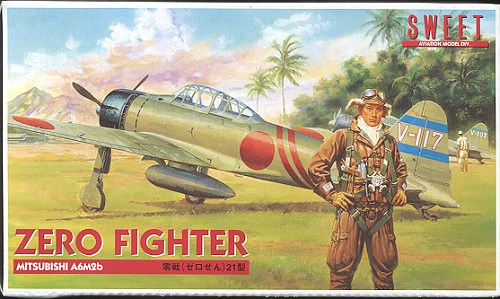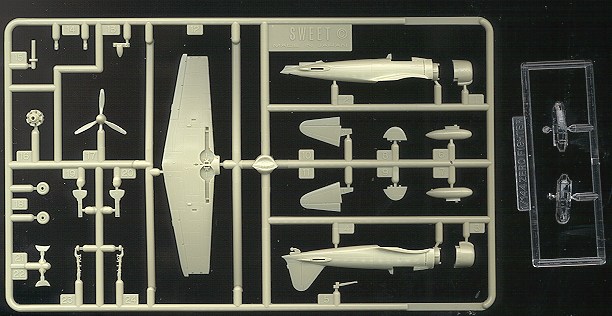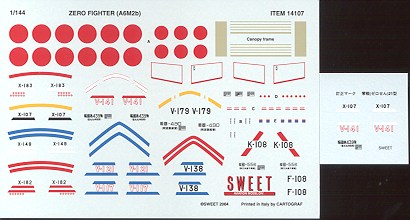
|
KIT: |
Sweet 1/144 A6M2b Zero |
|
KIT # |
14107 |
|
PRICE: |
¥1000 (about $9.50) at Hobby Link Japan |
|
DECALS: |
Eleven options |
|
REVIEWER: |
Scott Van Aken |
|
NOTES: |
Two kits |

|
HISTORY |
Undoubtedly the most successful Japanese aircraft of WWII was the A6M2 Zero. This early Zero was much feared by the Allies. Piloted by the most experienced pilots on either side (most of whom were enlisted), the Zero was able to rule the skies during the early days of the war. It wasn't until Allied pilots finally were able to discover the aircraft's weaknesses (mainly the lack of armor plating for pilot and fuel) that they were able to develop strategies for defeating it. Combine that with the loss of many of the more talented pilots during the battles for Guadalcanal, and the Zero stopped being so feared by the time that 1943 and the Corsair came into the picture.
|
THE KIT |

There is a reason why this model company is called Sweet. That is because it is one of the first things that you say when you open the box. These folks make the finest 1/144 fighters ever produced, and that is purely because they have thought things through before producing the kits. Engineering is excellent as is the detail, even in this scale. They are also quite easy to build with no real fussing and fiddling about to get things to fit.
The Zero is the third aircraft that they have done, the Macchi C.200, Hurricane, and FM-2 preceding it. I'm frankly a bit amazed that they did not start with this kit as the home market for Zeros is nearly insatiable, but I'm very glad that they chose an early war aircraft. Several reasons. One is that I think the early A6Ms are the coolest of the lot. Secondly, they were flown by many of Japan's Naval aces at some time during their careers, and third because the overall green-grey camouflage is easy to paint!
Included in the kit is a drop tank, and you can pose the wing tips in the raised position. The drop tank is not absolutely necessary and the kit is designed so that you do not have to install it if you don't wish. Providing a one-piece wing really helps with assembly as well. I should mention that all of the aircraft in this boxing are land based, so the tail hook would probably have been removed to save weight. Same goes for the radio mast. Japanese radios were notoriously poor so were not often carried and the radio mast would have been cut flush with the fuselage. In fact, the all Japanese instructions shows this being done and it applies to about half of the decal options.
 Instructions
consist of a single folded sheet with a four step construction sequence
on one side and a full color decal placement guide on the other. Painting
info is given though unreadable by me. The interior seems to be in a
green color with the upper fuselage inside the canopy, the main gear
legs, and the engine cowling in black. Markings are provided for no less
than 11 different aircraft from four groups; 3rd Flying Group, 4th
Flying Group, Tainan Flying Group and Kanoya Flying Group. Decals are by
Cartograf in Italy and are superbly printed. A small addendum sheet is
included to correct a few errors on the main sheet. Oddly, there are
enough roundels for three planes, though you'll only need those for two.
A really nice touch is that there are canopy frame decals. Masking the
canopies on these planes isn't very easy and that is much appreciated.
The trick now will be to match the paint you use to the decals!
Instructions
consist of a single folded sheet with a four step construction sequence
on one side and a full color decal placement guide on the other. Painting
info is given though unreadable by me. The interior seems to be in a
green color with the upper fuselage inside the canopy, the main gear
legs, and the engine cowling in black. Markings are provided for no less
than 11 different aircraft from four groups; 3rd Flying Group, 4th
Flying Group, Tainan Flying Group and Kanoya Flying Group. Decals are by
Cartograf in Italy and are superbly printed. A small addendum sheet is
included to correct a few errors on the main sheet. Oddly, there are
enough roundels for three planes, though you'll only need those for two.
A really nice touch is that there are canopy frame decals. Masking the
canopies on these planes isn't very easy and that is much appreciated.
The trick now will be to match the paint you use to the decals!
|
CONCLUSIONS |
These are really great kits and you deserve to treat yourself to one of them. If you can't wait until this kit hits the shores of the US (where they will retail for around $15, judging from what I've seen), you can get it now at www.hlj.com
If you would like your product reviewed fairly and quickly by a site that has over 250,000 visitors a month, please contact me or see other details in the Note to Contributors.